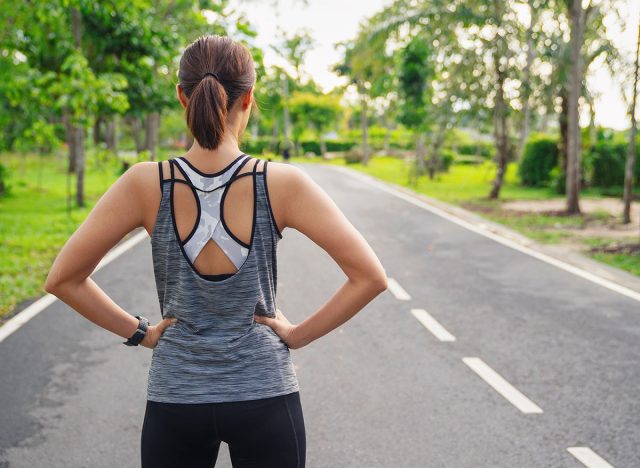I'm a Nutrition Pro: This 28-Day Walking Routine Burns More Fat Than Cardio
Autumn Bates is a Clinical Nutritionist with a Master's in Nutrition Human Performance. She is also a social media influencer with hundreds of thousands of followers, known for revealing tips on healthy eating, weight loss, and intermittent fasting. In a recent viral video, she reveals her 28-day fat-burning walking plan that anyone can do. "Walking is actually an insanely impressive tool for losing weight. And you don't need a gym to do it, but you do need some type of plan. If you do wanna see best results, say I'm sharing my 30-day walking for weight loss plan to help you tap into fat-burning mechanisms and achieve your weight loss goal," she says at the start of the clip.
Walking Is a Very Effective Workout
Autumn starts out by discussing the benefits of walking. "When walking is done the right way, it can help you to burn fat as fuel better. And because walking is a lower intensity exercise, it's inherently going to be burning more fat as fuel versus something like cardio, which is a higher intensity exercise," she says.
Walking Is Appropriate for All Fitness Levels
"Walking can also be done at pretty much any fitness level and any age," she says. "Also, if you have a belly fat loss goal, walking, especially if you can walk outside, has been found to lower the stress hormone. Cortisol and high levels of cortisol are directly tied to weight gain around the belly, but you need to walk enough and at the right frequency throughout the day, especially if you wanna really maximize your results from walking."
There Are No Rest Days

Don't plan on taking a day off. "My 30-day walking for weight loss plan doesn't actually technically include any rest days because walking is a lower intensity exercise. You don't really need to be resting from it. Unlike strength training, where you don't wanna be doing that every single day, we actually start to see negative results," says Autumn.
The Goal Is to Build Up Frequency and Volume

"The goal over the next 30 days is to build up the frequency and the volume that can then be maintained beyond that 30 days. This plan is perfect for beginners, but if you aren't a beginner, then you can just adjust the length of time for the walk throughout this plan," she says.
RELATED: 12-3-30 Walking Method: 20 Proven Tips to Lose Weight Faster
Week One
Week one is about "starting with the frequency groundwork," says Autumn. "We're building the habits of how frequently you're going to be walking throughout the day, so how frequently you're going to get up, stand and get some steps." She explains that her plan involves walking four times per day. "The first walk that you're going to do is first thing in the morning, preferably before you've eaten anything during this time, when you're technically fasted. And if you're using intermittent fasting, you can kind of double down on those weight loss perks. But even if you're not following intermittent fasting, you can at least get this walk in a fasted state, which means your body's already primarily burning fat as fuel. Therefore, you're just further tapping into this," she says. "The second time you're going to walk will be roughly around mid-morning. So, depending on when you wake up, this could be about 10 or 11:00 AM. This helps you break up the workday and get some movement in, especially if you've been stagnant and sitting throughout the workday." Then, she suggests walking during your lunch break and after dinner. "This is very strategic so that you can walk when it's dark out, and you can expose your eyes to darkness, which is really helpful for improving the sleep hormone melatonin and helping you to get the deep rest that you need after all of the exercises that you're getting throughout the day." Each walk should be just 10 minutes. "Five minutes out, turn around five minutes back. If you're not a beginner, then I would recommend upping this to 30 minutes for the first and the third walk," she says.
Week Two
Week two of the walking plan "is where we're gonna start to increase the length of time for each walk or rather for two of the walks," she says. Stick to the same schedule but "increase the time to 20 minutes for two of those walks, and I recommend that being the first and the third walk," she says. "So your morning walk and your lunch break walk, it's usually easier to get in first thing in the morning, and I've just found that I personally feel so much more energized when I get a longer walk in, first thing in the morning. So since this is a 20-minute walk, all you're looking at is 10 minutes out, turning around, 10 minutes back, and then we're keeping the second and fourth walks the same at just 10 minutes."
RELATED: 10 Foods That I Will Never Eat Again After Losing 120 Pounds
Week Three
"Week three is where things switch up a little bit. During this week, we're not only going to increase the length of one of your walks, we're also going to add in these mini standups," she says. Increase the first walk to 30 minutes. "There's also one more addition here, and that's every hour of the workday. You're also going to make sure that you're getting at least 250 steps. That equates to about one to two minutes of walking," she says. "Over an eight-hour period of time throughout the workday, getting that 250 steps adds up to an extra 2,000 steps every single day. That's an extra 14,000 steps a week that you're getting just by getting one to two minutes of walking every hour."
Week Four
During the final week, she recommends increasing the length of the third walk to 30 minutes. "Your daily schedule by week four will now look like this: Your first-morning walk in that fast state will be 30 minutes. The second walk will just be a quick 10-minute walk. The third walk will be a 30-minute lunchtime walk, which is actually really great for digestion, for getting up and walking after you've eaten. And then, the fourth walk, you're going to do that 10-minute evening walk after you've eaten dinner, and then throughout the day, if you didn't already hit 250 steps for each hour, then you're just going to get up and move around a little bit," she says.
It's Easy to Fit Into Your Schedule
"It sounds like a lot, but it is surprisingly really easy and fits into even a busy schedule. This is actually pretty much my exact walking schedule every day, and I find that it makes me really energized, feel so much more focused when I come back from these walks and get back to work," she notes.
RELATED: 7 Foods You Should Never Eat, According to a Nutrition Expert
Add As Many Steps As You Can
"Help to make sure that you're adding even more steps in depending on your pace. This schedule should be about 10,000, 12,000 steps that you're going to be getting in each day, but you also really wanna make sure that you're avoiding super common walking mistakes that could be holding you back from achieving your goals," she concludes. And if you enjoyed this article, take advantage of these 15 Quick Ways to Lose Body Fat Percentage in a Week.





